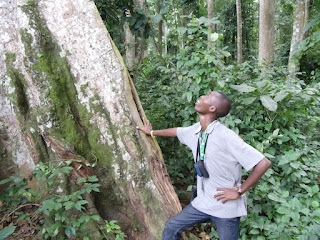Advocacy roles of youth in climate change mitigation in sub-Sahara Africa Introduction
Issues regarding the changing climate have remained a phenomenon of
concern among major stakeholders most especially policy makers from all around
the world. And recent events have
emphatically demonstrated our growing vulnerability to climate change. Climate
change impacts range from its effects on agriculture, further endangering food
security, to sea-level rise and the accelerated erosion of coastal zones increasing
the intensity of natural disasters, species extinction, and spread of
vector-borne diseases. This issue is of immense importance for every global
citizen. Hence it has risen on a scale of heightened concern from every quarter
of the world and which in turn requires initiatives against it globally.
In Africa, most especially the sub-Sahara part stands the
greater risk of being the worst hit by the effect of climate change. In the
regards of been a typical agrarian society which largely depends on rainfall
for food production, poor governance, high level of poverty, lack of infrastructure, adaptation capacity and lack of awareness as a result of
high illiteracy couple with the fact
that of highly congested urban areas.
Overtime the effects of the changes have been
felt in the decline of food production which is as a result of erratic and
unpredictable rainfall pattern, also the constant flooding in the coastal
cities, increase in heat induced diseases such as malaria.
Climate change projections for Africa agree that Africa will
experience a strong warming trend over the 21st century (roughly +2.0 to +4.5°
C by 2100 in sub-Saharan Africa), which is
expected to be stronger than the global average. Therefore for this reason,
there have been quite a number of advocacy projects by government agencies,
complementary effort from civil societies, Non-profit organization and most
importantly youth groups.
However, it has been noticed of the fact that there have risen a
number of youth networks and which as reflected a great deal of youth engaged
activism in the fight against climate change. The youth seem to play a more
tangible role in the advocacy projects in tune with the mitigation and
adaptation strategies in the face of climate change.
Sub Saharan African now witnesses a significant increase in youth
engagement in environmental issues compared to some twenty years ago.
Footprint of the roles of
youths
The theme of International Youth Day, 2008, was
“Youth and Climate change: Time for action.” In his address, Ban Ki-moon,
Secretary-General of the United Nations said young people who are adept at
spreading new habits and technologies are well placed to contribute to the
fight against climate change. Mr. Ban stressed: “They (youth) are adaptable and
can quickly make low-carbon lifestyles and career choices a part of their daily
lives. Youth should therefore be given a chance to take an active part in the
decision-making of local, national and global levels. They can actively support
initiatives that will lead to the passage of far-reaching legislation. This is
an extract from the UN secretary general which greatly reflects the fact that
contribution of the youth his highly significant in the fight against climate
change.
The evolution and the increase in the level of
exposure and educational status of the
youths in sub-Saharan Africa has risen
significantly in recent times and which has allowed a reasonable participation
in international processes in the like of the United Nations Framework
convention on climate change . A number of youths in this wise have facilitated
relationship with youth networks and related organization across the world and
through this, innovations and new ideas have been generated and applied to fit
in to our environment here in the sub-Sahara part of Africa.
Vivid facts are seen in the number of advocacy
projects coordinated by these youths all around. Often these advocacy projects
take the form of tree planting campaigns, awareness reach out to education
facilities, public march and awareness creation.
The flexibility and the tenacity of the
motivated individual has yielded quite a
number of benefits as the actions have
attracted more youths and even the
governments are realizing the impacts of these youths and in some way engaged them
in governmental processes and functions that would enable the their
contribution.
All across the west coast of Africa,
a lot of youth actions have stemmed up and there seem to be a synergy of
operation in their actions. Some vivid examples are the African youth
initiative on climate change which is a pan –African alliance of African youths
in the fight against climate change, another example is the Nigerian Youth
coalition on climate change. All of these networks have given a common voice
and platform for the operation and actions of the youths.



Comments
Post a Comment